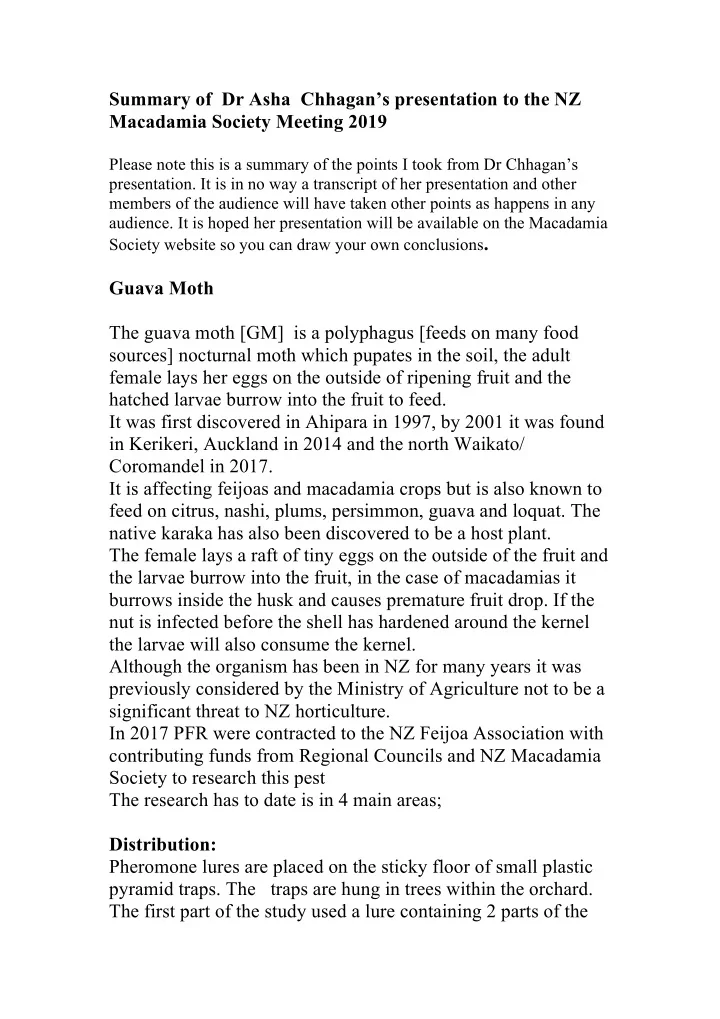

Summary of Dr Asha Chhagan’s presentation to the NZ Macadamia Society Meeting 2019 Please note this is a summary of the points I took from Dr Chhagan’s presentation. It is in no way a transcript of her presentation and other members of the audience will have taken other points as happens in any audience. It is hoped her presentation will be available on the Macadamia Society website so you can draw your own conclusions . Guava Moth The guava moth [GM] is a polyphagus [feeds on many food sources] nocturnal moth which pupates in the soil, the adult female lays her eggs on the outside of ripening fruit and the hatched larvae burrow into the fruit to feed. It was first discovered in Ahipara in 1997, by 2001 it was found in Kerikeri, Auckland in 2014 and the north Waikato/ Coromandel in 2017. It is affecting feijoas and macadamia crops but is also known to feed on citrus, nashi, plums, persimmon, guava and loquat. The native karaka has also been discovered to be a host plant. The female lays a raft of tiny eggs on the outside of the fruit and the larvae burrow into the fruit, in the case of macadamias it burrows inside the husk and causes premature fruit drop. If the nut is infected before the shell has hardened around the kernel the larvae will also consume the kernel. Although the organism has been in NZ for many years it was previously considered by the Ministry of Agriculture not to be a significant threat to NZ horticulture. In 2017 PFR were contracted to the NZ Feijoa Association with contributing funds from Regional Councils and NZ Macadamia Society to research this pest The research has to date is in 4 main areas; Distribution: Pheromone lures are placed on the sticky floor of small plastic pyramid traps. The traps are hung in trees within the orchard. The first part of the study used a lure containing 2 parts of the
female pheromone. The pheromone attracts the male moths which are trapped on the sticky pad. Regular checking of the traps and removal of the dead moths means a count can be kept of infestations throughout the season. This has been a helpful mechanism to monitor the regional distribution of the moth. The second part of the distribution study used the 4 component lure [8 x more powerful attractant]. The study so far has found GM infestations from Northland to the North Waikato and Coromandel. Single organisms have been trapped as far south as Tauranga but it is thought this organism may have been introduced on infected fruit carried into the area as no further moths have been trapped in those areas. To date no moths have been found in Gisborne, Hawkes Bay, Taranaki or Nelson. However initial projections suggested the moth could potentially survive in all those areas. Natural Enemies : 7000 pieces of fruit have been inspected to date in NZ and no parasitoids [natural enemies] have been found. Work has previously been carried out in Australia, by NZ PFR to identify GM’s natural enemies. The GM is native to Australia but causes little problem to the macadamia or other crops in its homeland possibly because it is kept in check by a natural enemy. The research did not identify a specific organism and is not ongoing. Semiochemicals; Pheromone traps: This year PFR are investigating whether increasing the density of lure traps will decrease crop loss. A comparison is being made between a density of 3 traps per hectare and 300 traps per hectare. The study is being undertaken in two macadamia orchards and 4 feijoa orchards. Results are awaited. Mating disruption using pheromones : Pheromones twist ties [for the Asian Peach moth , a moth similar to GM] hung in the trees can theoretically be used to
cause mating disruption. The confused males fly about in the fog of pheromone looking for the female emitting such a powerful scent but because there are multiple sources of the pheromone their flight path is erratic and they cannot find or mate with a female. Ties were placed in 6 orchards in November 2018 . Again results are awaited. Lure and Kill using plant chemicals: Andrew Twidle PFR Linclon is studying whether the plant volatiles which attract the GM to ripening fruit can be used to lure the moth to a situation where they can be killed. Insecticide trials: A Potter Spray Tower is being used to investigate which insecticides GM is susceptible too. NZ Macadamia Society is grateful for PFR’s ongoing research in this area and their results are eagerly awaited. My personal opinion : This pest has caused huge loss of production for many macadamia orchards in the North and is known to affect both droppers and stick tight varieties. Growers in areas not yet affected should be paying attention as this organism may not yet have finished its steady march down country. Donna Hardie, Outgoing secretary
Recommend
More recommend